Items
topic_interest is exactly
vaccine
-
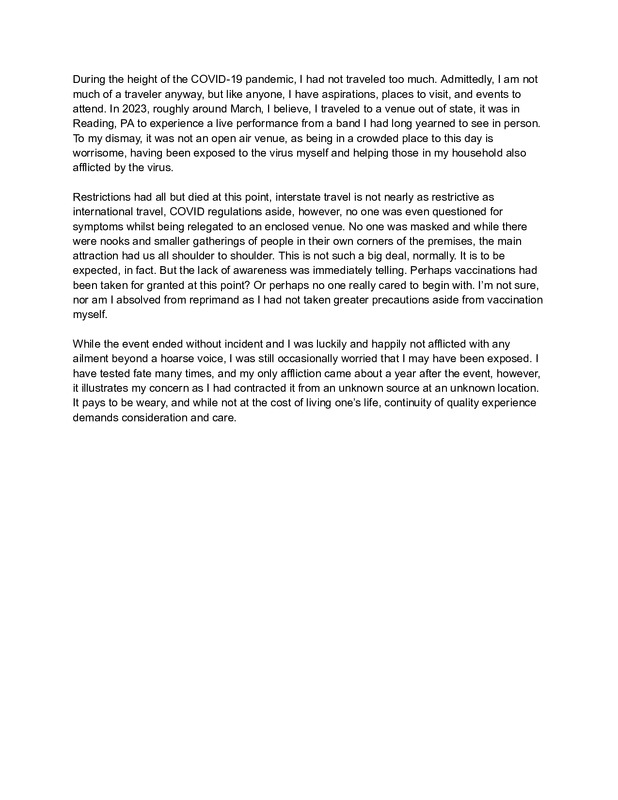 2024-03-14
2024-03-14Reflection on the Attitudes About COVID-19: A Concert Venue
The photograph is not so much exemplary of my thoughts as much as the story. Even then, it was very late and much of the "heat" surrounding COVID had since died down. Regardless, it serves as a reflection of my thoughts concerning the attitudes regarding COVID-19 and its treatment when attending certain events. It is among the few travel experiences I have, however, it is an important time to me. The story explains the general unconscious aversion to COVID consideration, at least, as I understand it upon reflection. -
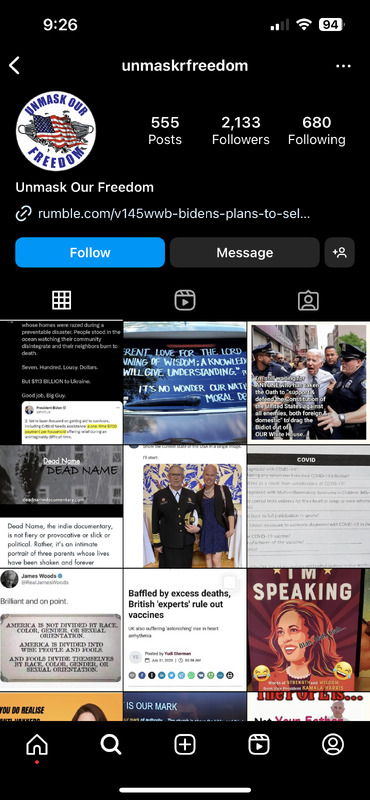 2023-08-30
2023-08-30COVID paranoia alive and well in 2023
At a stop light this morning, my attention was grabbed by a car with lots of writing on it. I wish I could have gotten a picture, but the light turned green before I could. The car message was about Marxism and how fear controls its movement. The message expressed that recent events have all been staged in order to control society and went on to predict that mask mandates would be back on September 15. The message ended by encouraging people to resist the future mandate in order to retain control of our society. I was very intrigued to see that there are some people who are still very vocal about topics such as this and very loudly are telling people not to live in fear when they are the only ones who seem to be living in fear these days. I read a hashtag on their car and looked it up when I got home. This page belongs to a person (or movement) that is very anti-mask, anti-covid vaccine, and anti-mandates. They are part of the extreme right politically and very religious. I’m curious to see if anything were to happen on the 15th and if not, how this page will respond to the “normality” of September 15. I guess we’ll see in two weeks. -
2022-06-01
Covid Europe
My family and I really like to travel, like a lot. We usually do a big vacation every year, and Covid-19 really threw a wrench in our annual plans (as it did to every single person alive). March of 2020, my family and I had traveled to Washington D.C. When we got back home to Utah, not even 24 hours later, Washington D.C. had shut down entirely. We felt lucky we got to go, but hopeful this shut down would only be two weeks. Fast forward two years, and we (again, like the rest of the world) were unable to go anywhere. My sister and I had gotten Covid-19 in November of 2020, and then the vaccines started to roll out. We had heard that if you were fully vaccinated, places were starting to slowly open for those individuals. We thought since we already had Covid-19, why not get vaccinated so we could travel? So, my mom, myself, and my sister all got vaccinated. Solely to travel. We are by no means 'anti-vaccination' people, actually quite the opposite. But we did have the normal hesitations of getting this vaccine just to such little prior research. Regardless, we got the vaccine. We started looking at places where we could go, from cruises to domestic travel to international. And then, the booster comes out. The rules are now that you have to have all three shots. And then, I get Covid-19 again in November of 2021, after having been fully vaccinated. Finally, we start to plan a Europe trip for the summer of 2022. Every plane, train, and automobile that would take us to and around Europe required a valid Covid-19 vaccination card. There were so many Covid-19 tests we had to take prior to departure from the US, then when we got to Europe, and then when we were getting ready to return home to the US. We had to fill out numerous forms verifying that we were not sick and had not been sick in the previous 14 days. While we were in Europe, the mask mandate had lifted for everywhere but Austria, but we didn't know that. We went to board an Austrian airlines flight without a mask, and we were then told we could not fly without a mask. We had to beg the flight attendant to give us one, as we didn't know (they were not nice about it). Keeping up with everyone's different rules and regulations and testing and forms definitely made our trip more difficult than it would be now. -
 2022-09-21
2022-09-21ArriveCan application and Canada's COVID-19 vaccine border requirements
This news article reports Canada's plan to drop its COVID-19 vaccine border requirements, make the ArriveCan application optional, and possibly end COVID-19 testing for travelers by the end of September 2022. This news shows how the COVID-19 pandemic impacted travel and border relations between countries (Canada and US). -
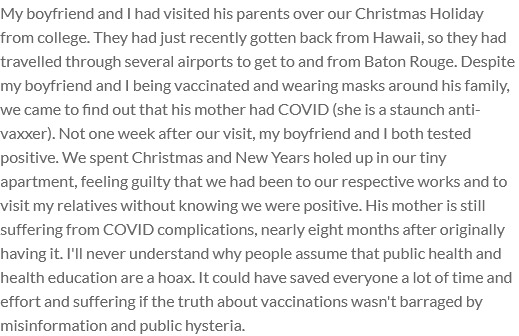 2021-12-20
2021-12-20And a Happy New Year
My boyfriend and I had visited his parents over our Christmas Holiday from college. They had just recently gotten back from Hawaii, so they had travelled through several airports to get to and from Baton Rouge. Despite my boyfriend and I being vaccinated and wearing masks around his family, we came to find out that his mother had COVID (she is a staunch anti-vaxxer). Not one week after our visit, my boyfriend and I both tested positive. We spent Christmas and New Years holed up in our tiny apartment, feeling guilty that we had been to our respective works and to visit my relatives without knowing we were positive. His mother is still suffering from COVID complications, nearly eight months after originally having it. I'll never understand why people assume that public health and health education are a hoax. It could have saved everyone a lot of time and effort and suffering if the truth about vaccinations wasn't barraged by misinformation and public hysteria. -
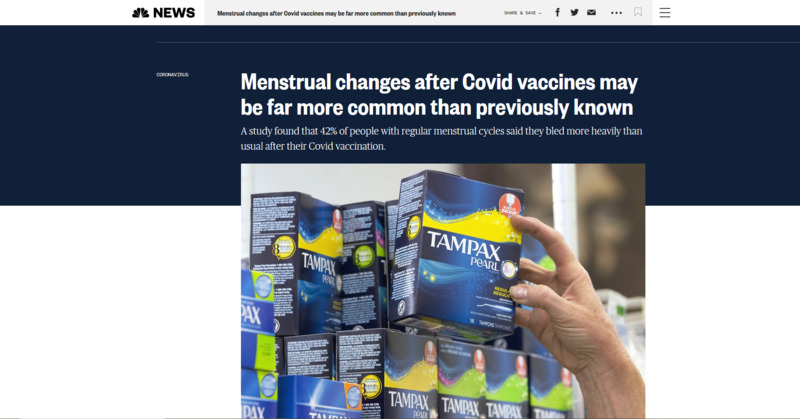 2022-07-15
2022-07-15Menstrual changes after Covid vaccines may be far more common than previously known
This is a news story from NBC News by Sarah Sloat. Since vaccines have been administered for the last year, new information has come out on how they effect the human body. The journal, Science Advances, found 42% of women with regular menstrual cycles bled more heavily after vaccination. 44% said no change occurred, while 14% reported lighter periods. There is no mention on if this side effect has any effect on fertility. -
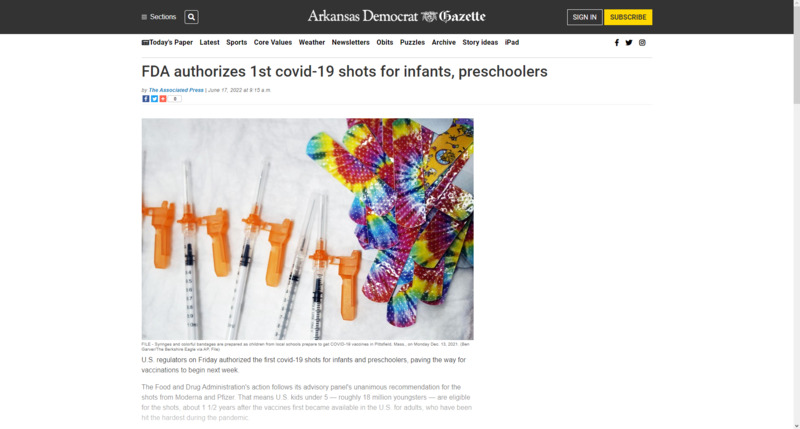 2022-06-17
2022-06-17Shots for the Youth
This article details the FDA's approval for vaccinations of children and infants. With encouragement from the Biden Administration, the youth are the final group with full approval for vaccinations against COVID-19. While this is a good thing for many who take the pandemic seriously, many Arkansans and southerners in general will likely be resistant to this new approval. The south has largely been skeptical of the vaccine and of COVID, and indeed the vaccinating of children with be a harsh topic across the south. It will be interesting to see the backlash and discussion from this decision, as well as analyzing the many questions that will doubtlessly be raised about the powers of the parents. -
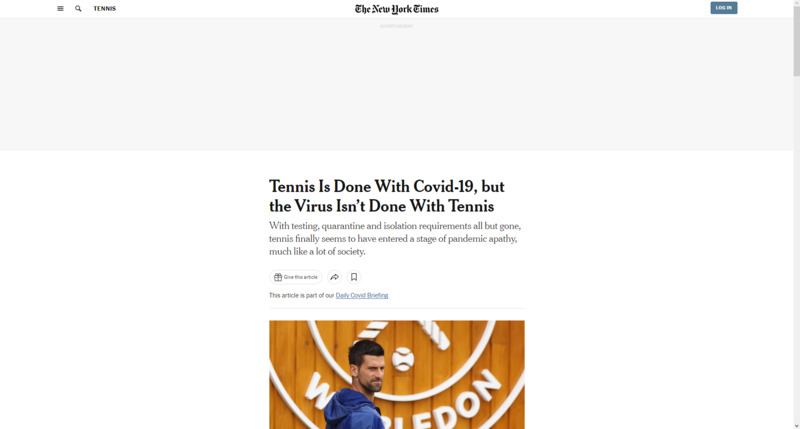 2022-07-10
2022-07-10Tennis Is Done With Covid-19, but the Virus Isn’t Done With Tennis
This is a news story from The New York Times by Matthew Futterman. This story chronicles the changes tennis has gone through during the pandemic. Compared to other professional sports, tennis has been one of the sports with restrictions applied the longest Novak Djokovic, one of the top tennis players in the world, is noted for his refusal of the COVID vaccine. This caused controversy in 2021 at the Australia Open, where his refusal to get vaccinated resulted in his deportation. The Australian government was worried that his refusal would embolden others. The rest of the article goes on about what other tennis players have said about the restrictions, and what they mean for the sport. Some of the tennis players expressed not paying attention to restrictions as much as they used to, and wanting to live like they used to. -
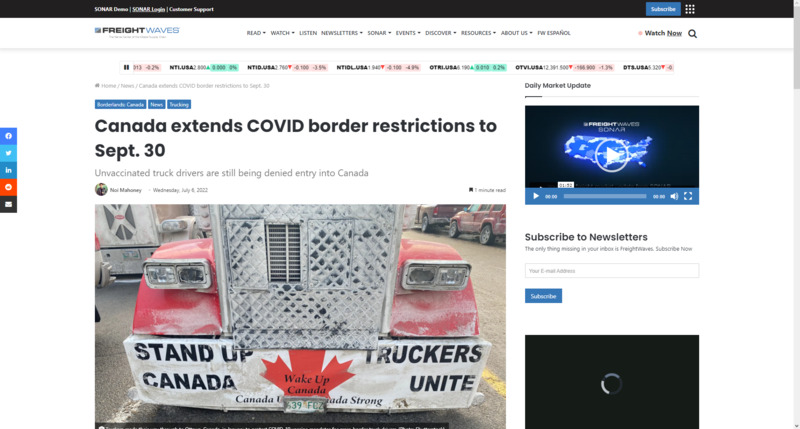 2022-07-06
2022-07-06Canada extends COVID border restrictions to Sept. 30
This is a news story from Freight Waves by Noi Mahoney. Canada's vaccine mandate for border-crossing truck drivers will remain in place until September 30. Americans crossing the Canadian border must be fully vaccinated and are subject to random testing. About 30,000 trucks cross the Canadian border each day. -
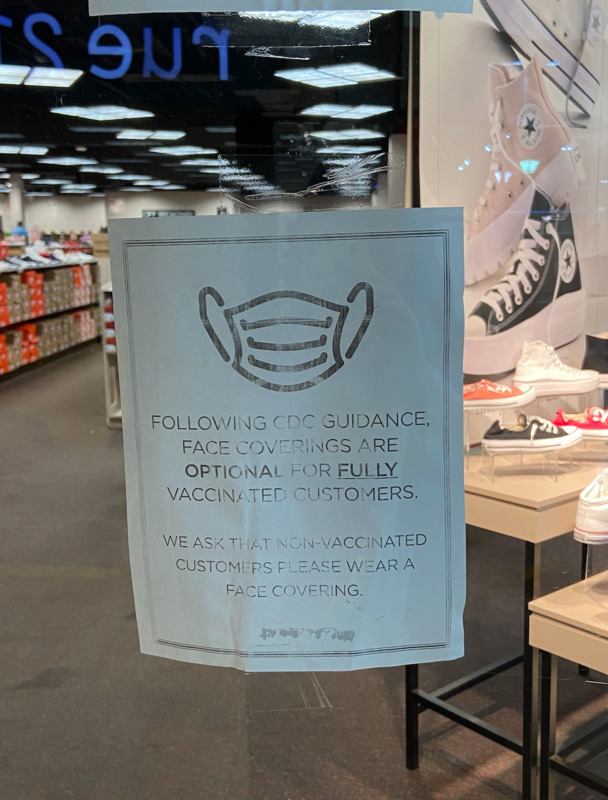 2022-07-05
2022-07-05Masks optional for fully-vaccinated customers
This is a sign I found outside a shoe store at Arizona Mills Mall. It says that masks are optional for fully-vaccinated customers. I didn't go in the store, so I don't know if they would check for vaccination status or not. From my experience with other places with similar signs, no employee has asked about my vaccination status before shopping. I could see this being enforced a year ago, but not now. -
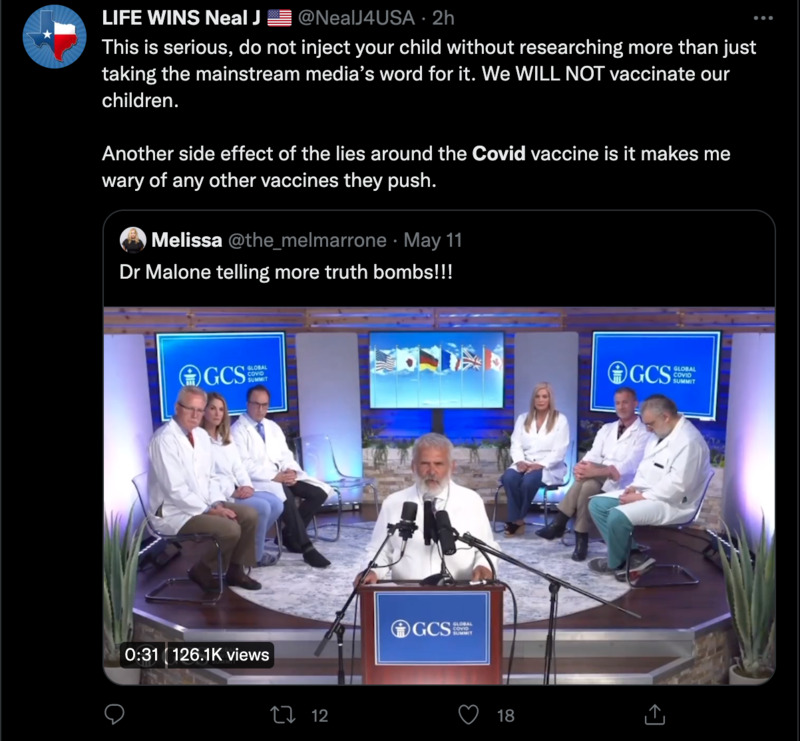 2022-06-25
2022-06-25Do not inject your child without research
This is a tweet from NealJ4USA. This person has decided not to vaccinate their children after having done some research on the subject. Due to distrust in the COVID vaccine, it is also making this person feel more hesitant about any other vaccines that end up getting pushed. -
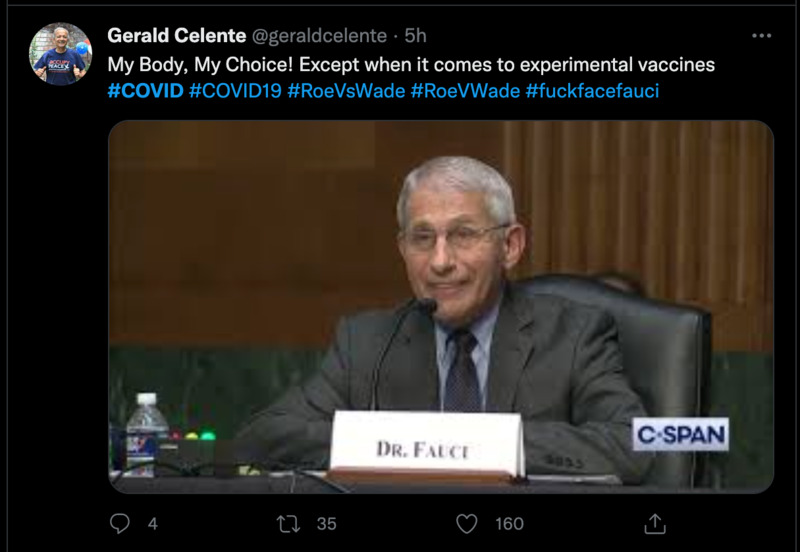 2022-06-25
2022-06-25My body, my choice...except with experimental vaccines
This is a tweet from geraldcelente. This person is expressing their anger towards Dr. Fauci and his ideas on what "my body, my choice" actually consists of. Within the vaccine skeptic communities, people like Dr. Fauci are held in contempt due to his stances on things like masks, vaccines, and lockdowns. -
 2022-06-25
2022-06-25I FINALLY got my second Pfizer covid booster shot!
This is a tweet from bobbicallie. This person is announcing the joy they have in receiving their second COVID booster shot. They are also worried about long COVID, so despite getting the vaccine booster shots, this person has decided to continue wearing a mask. -
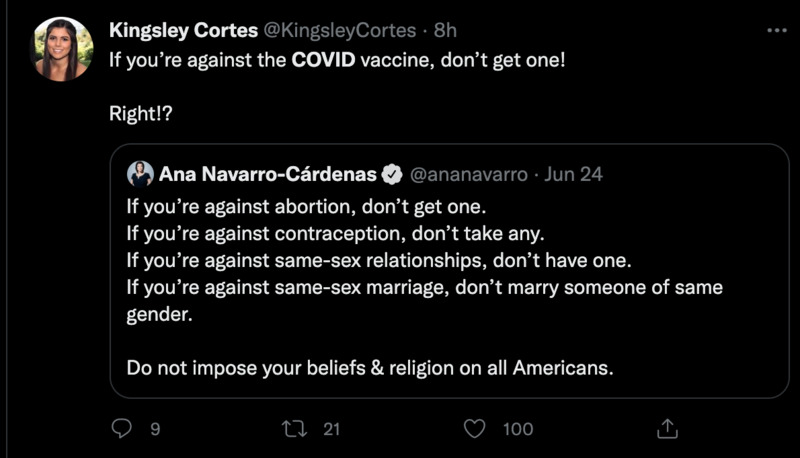 2022-06-25
2022-06-25Calling people out
This is a tweet from KingsleyCortes. She is criticizing the general Democrat talking points with things like abortion and gay marriage by pointing out that many Democrats were in favor of people getting the vaccines. The vaccines were not voluntary in some cases, where people were coerced into getting them at the risk of losing their jobs. People have many different takes on these hot button issues, but this is the best way I can explain it. -
2022-06-25
The same sort of people
This is a tweet from Connybub. This person is pointing out the hypocrisy of the pro-choice crowd and their use of "my body, my choice" while many in this same group also wanted people to take the vaccines against their own will. This is obviously a very controversial topic, and there have been people using different aspects of the vaccine debates and the abortion debates to show which side in the correct one. -
 2022-05-03
2022-05-03COVID protocol and abortion
This is a tweet from CJ_isnowblue regarding the leaked opinion from the Supreme Court on abortion. She is criticizing the way Republicans have protested for their rights to bodily autonomy on things such as mask mandates and vaccines, while wanting to restrict the bodily rights women have. Throughout the pandemic, the abortion debate has come up a time or two due to the "my body, my choice" rhetoric being used by those against masks and vaccines. Prior to this, it was mainly used for discussions on abortion, but now the two subjects are getting linked in public discourse. -
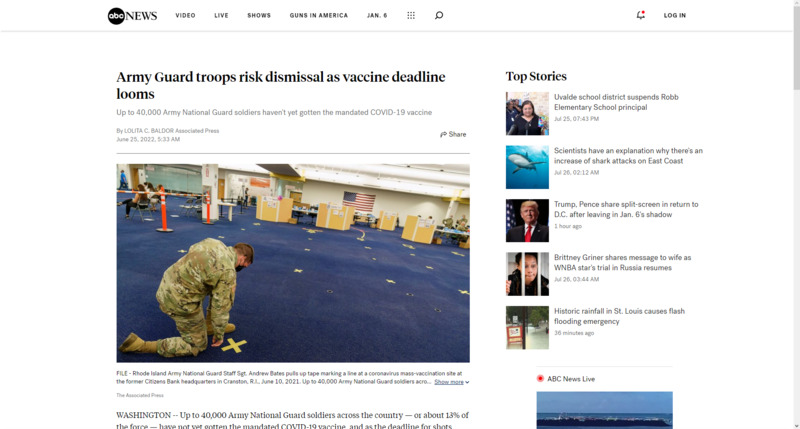 2022-06-25
2022-06-25Army Guard troops risk dismissal as vaccine deadline looms
This is a news story from ABC news by Lolita C. Baldor. Up to 40,000 National Guard soldiers, which consists of roughly 13% of the force, have not yet received the mandated COVID vaccine. Soldiers have until Thursday to get the vaccine. Out of all military branches, the National Guard was given the largest window to fulfill that requirement. -
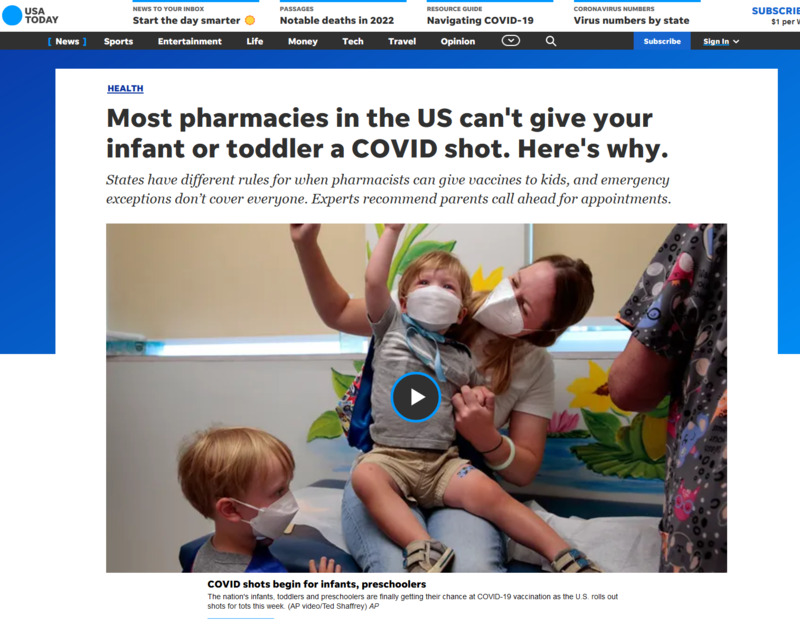 2022-06-23
2022-06-23Most pharmacies in the US can't give your infant or toddler a COVID shot. Here's why
This is a news story from USA Today by Adrianna Rodriguez. Most US pharmacies don't allow their technicians to administer the vaccine to children under five. The age in which the vaccines can be ministered to younger kids varies, with most putting a minimum of five or above. A lot of the reason administering vaccines has been restricted, according to the article, is because not enough pharmacists are trained to give shots to children that young. The overall target is smaller, and the needle even shorter, in addition to needing to calm and anxious child. This makes people hesitant to give young kids the COVID vaccine. It is recommended that if you cannot find a pharmacy that will give the shot to very young kids that you ask your pediatrician for a one-on-one appointment for the vaccine. -
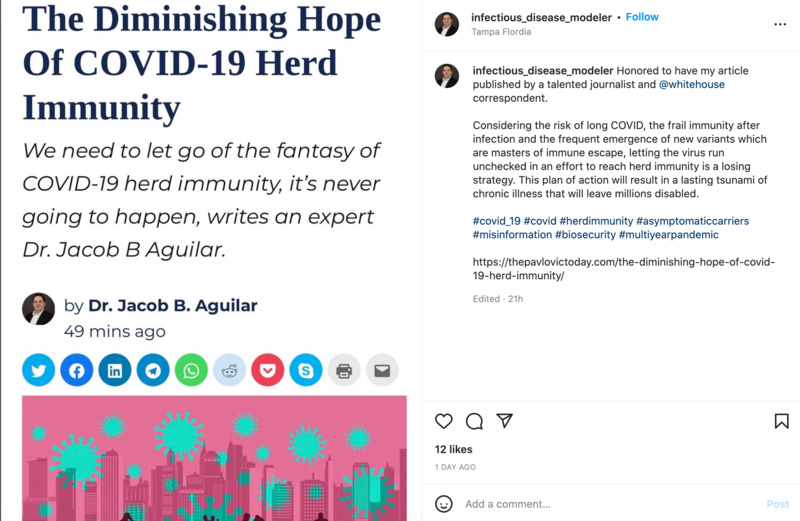 2022-06-16
2022-06-16The Diminishing Hope of COVID-19 Herd Immunity
This is an Instagram post from infectious_disease_modeler (Dr. Jacob B. Aguilar).He wrote an article about how herd immunity doesn't work with COVID as well as it could due to new variants that keep on happening. He says that if vaccines had a 100% effectiveness rates across all situations, this would not really be an issue. Since the vaccines are not entirely effective, the solution, Dr. Aguilar proposes that the way to help mitigate the issue is mass regular testing to slow the spread of new variants. -
 2022-06-17
2022-06-17Victoria pressed to scrap two-jab Covid vaccine mandate amid worker shortage
This is a news story from The Guardian by Adeshola Ore. The Victorian government has been pressed to stop the two-jab vaccine mandate due to a worker shortage. "While some industry groups have called for the two-dose mandate to be abolished to help ease the skilled workers shortage, the Victorian Chamber of Commerce and Industry (VCCI) said the decision was up to health officials." "Almost 95% of Victorians aged over 12 have received two doses of a Covid vaccine." -
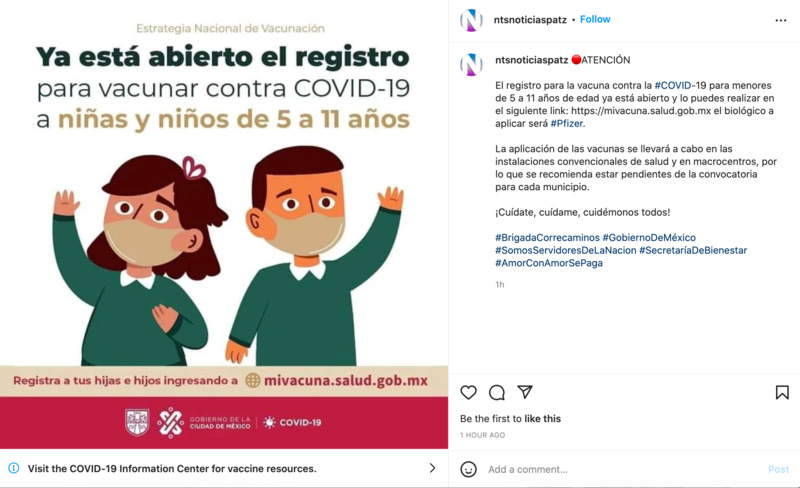 2022-06-17
2022-06-17Vaccines for kids 5-11
This is an Instagram post by ntsnoticiaspatz. It is saying that if you have not, you should register your kid to receive their vaccine. This is being promoted by the Mexican government. -
 2022-06-08
2022-06-08Moderna says updated Covid-19 vaccine booster shows stronger antibody response against Omicron
This is a news story from CNN by Jamie Gumbrecht. Moderna believes that their COVID-19 booster is effective against Ominicron, and more effective compared to the normal two doses. The claim is that the booster provided a stronger antibody response than the initial two doses. -
 2022-06-09
2022-06-09Biden administration lays out its plan for Covid-19 vaccinations for children under 5
This is a news story from CNN by Donald Judd and Betsy Klein. The Biden administration has announced a vaccine rollout for children five and under. The vaccinations are to start as early as the week of June 20. -
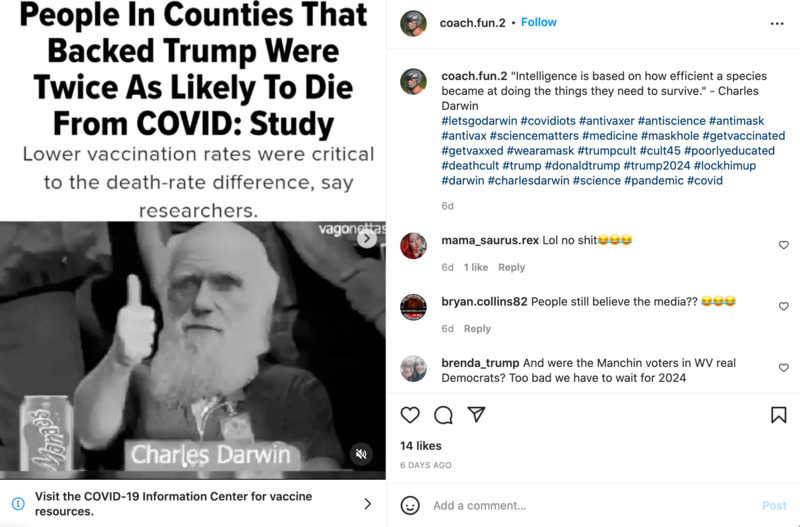 2022-05-22
2022-05-22People in counties backed by Trump were twice as likely to die from COVID: Study
This is an Instagram post by coach.fun.2. The study is not linked in the description, but I did find the article the title is referencing. The story come from the Huffington Post. It says that political affiliation is linked to vaccination rates, which some claim are what is making the difference between living and dying from COVID. Wealth and access to certain care are also taken into account. The study was from Brown and the study claims that states that went heavily for Trump had more cases of COVID deaths. -
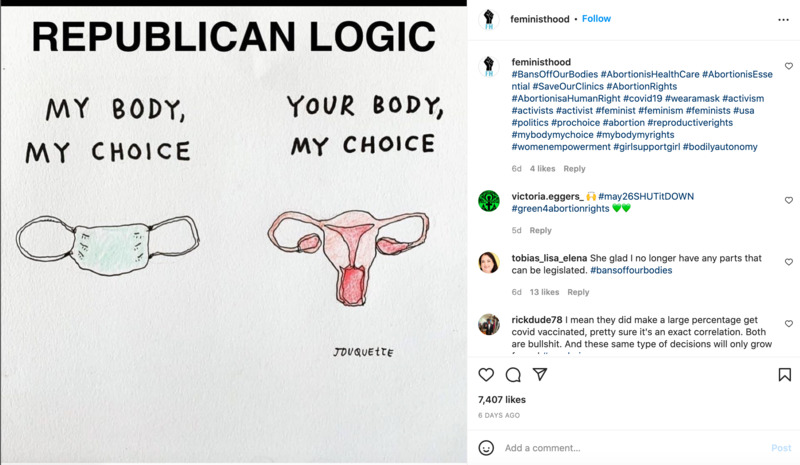 2022-05-22
2022-05-22Republican logic
This is an Instagram post from feministhood. It is making the comparison between the rhetoric Republicans have had regarding COVID versus abortion. The person writing this says thinks that it is rather contradictory. The contradiction comes from thinking that "my body, my choice" applies to masks and vaccines, but should not apply to abortion. The commonality is that both issues deal with bodily autonomy. -
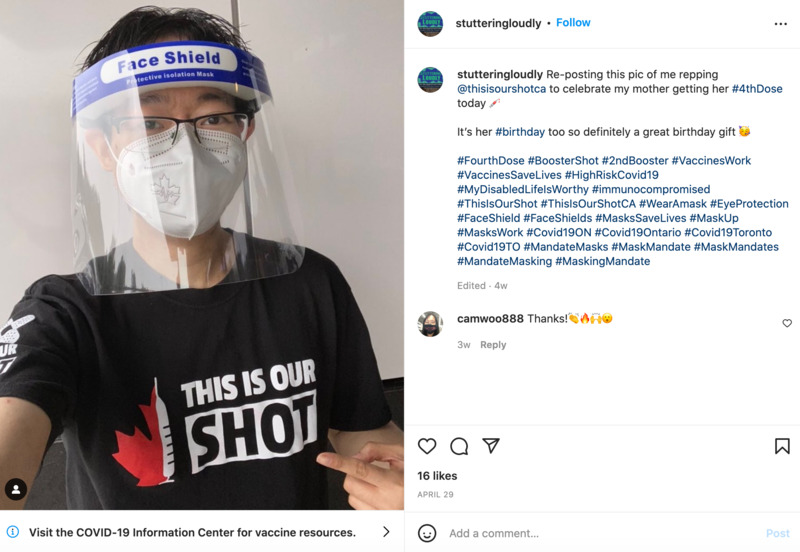 2022-04-29
2022-04-29This is our shot
This is an Instagram post by stutteringloudly. This person is celebrating his mom getting her fourth dose. -
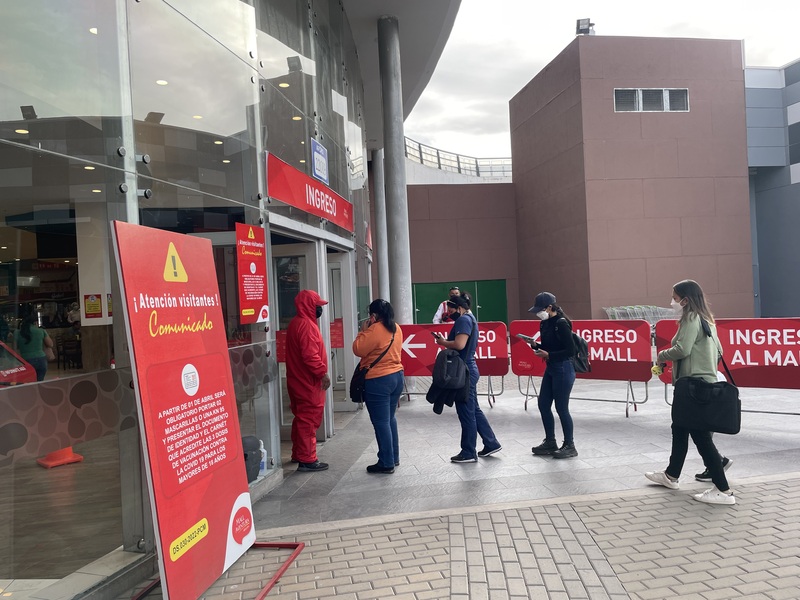 2022-05-25
2022-05-25Vaccine check control at mall Aventura
All guests have to have 3 vaccines and an N-95 or double facemask to enter the mall. The flow of in and out of the mall are still controlled. -
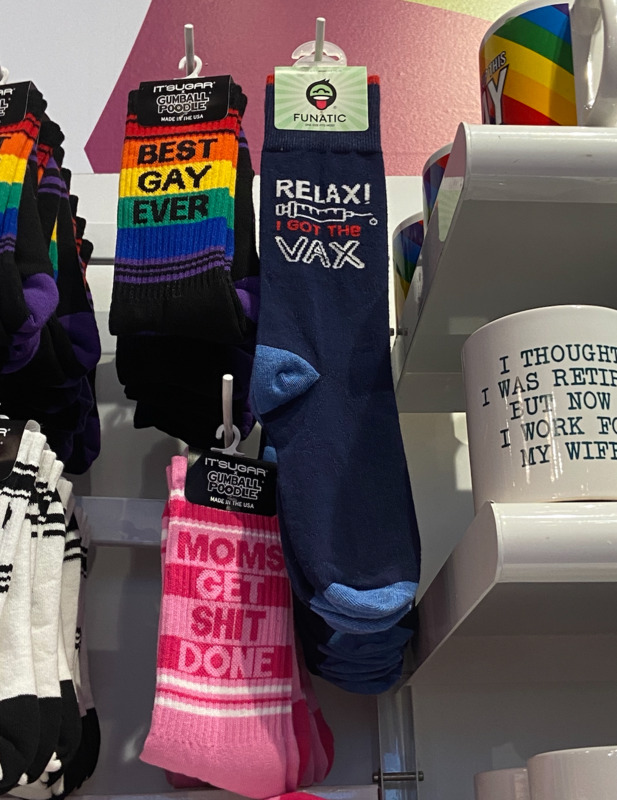 2022-05-23
2022-05-23Relax! I Got the Vax
This is a pair of socks I found at It's Sugar. They say "Relax! I Got the Vax" on them. This is referencing the COVID vaccines people have gotten. Now, places are selling merchandise referencing it as a way to get more money. Things like this are not uncommon and many big stores will sell vaccine related merchandise. I have no idea how well it actually sells, but there must be some market out there for companies to keep producing it. -
 2022-05-23
2022-05-23Cart Wipes at Target
This is where you can get cart wipes at Target while shopping. In addition to the thing itself, it gives you information on where to get a COVID vaccine. Wiping down surfaces has become a bigger thing since COVID, as it would help reduce the spread. COVID itself can't survive on surfaces for very long, but it can be there for a short amount of time. Using things like cart wipes is a way to prevent COVID and other diseases. -
 2022-05-21
2022-05-21Is monkeypox the next big pandemic? Here's why it's not time to panic.
This is a news story from NBC News by Tara C. Smith. This is comparing COVID to the recent monkeypox outbreak. Unlike the COVID, Smith says that monkeypox has had more understanding due to it being related to smallpox. Monkeypox is milder than smallpox and is more difficult to spread compared to something like COVID. However, monkeypox and COVID do have some things in common. One of them is that both are respiratory viruses, meaning that they can be spread through cough, sneeze, and sometimes breathing. One very good thing about monkeypox is that there are already vaccines available that can work against it. The smallpox vaccine is similar enough to monkeypox that it can help prevent both. -
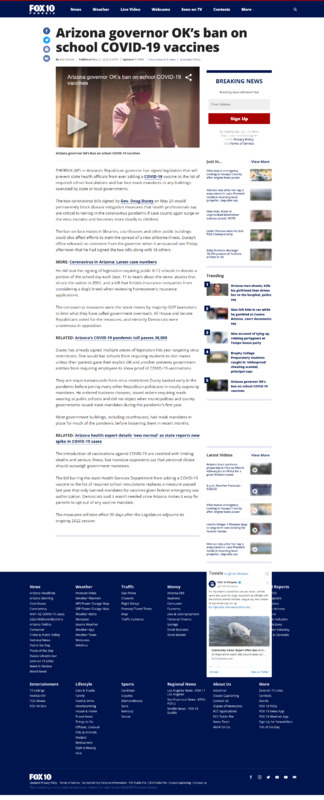 2022-05-21
2022-05-21Arizona governor OK’s ban on school COVID-19 vaccines
This is a news story from Fox 10 News by Bob Christie. Governor Doug Ducey has recently signed legislation that would prevent state health officials from adding COVID-19 vaccines to list of required school vaccines. This legislation was done by the GOP to prevent government overreach. -
 2022-03-09
2022-03-09The Pfizer Documents
This is a video regarding the safety of the Covid-19 Phizer vaccine reports that were recently released as of the making of both the video and this submission. It details the adverse events, the safe deliveries of the vaccine amongst an assortment of disorders, and the unhappiness of both the video creator and the viewers in the comments at the lack of transparency regarding the information surrounding the vaccine. -
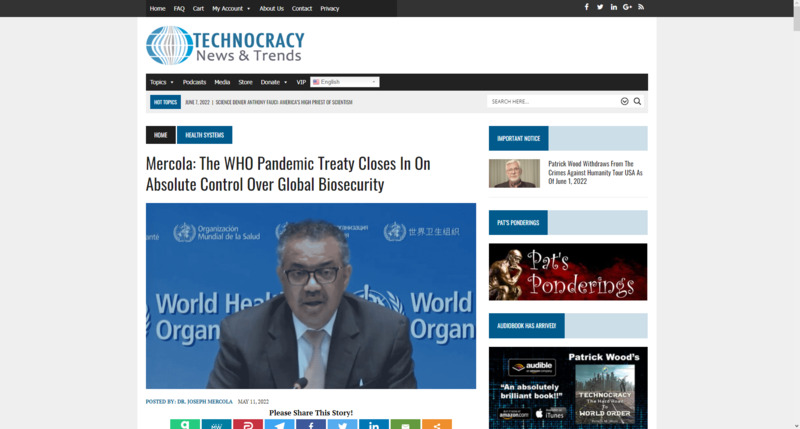 2022-05-11
2022-05-11WHO Plans Global Takeover: The Pandemic Treaty
American alternative medicine proponent, Joseph Michael Mercola, stated that the World Health Organization (WHO) has started drafting a global pandemic treaty in preparation of a global takeover. in biosecurity. This treaty would grant WHO absolute power over digital identities, vaccine passports, mandatory vaccinations, travel restrictions, standardized medical care, and more. Although the World Health Organization does not currently have absolute authorization over international public health, Mercola argues that the agency is working with the United Nations to pass this treaty on June 16th and 17th so that they may seize absolute control over these entities in order to strip civilians of their basic rights and freedoms based on claims and statistics that seem to exaggerate the climate of the pandemic and its transmissions. As a reader, I am somewhat amused and concern with this information, not because I believe it to be true but because I know that it is heavily misguided. For starters, Mercola tries to persuade readers that the WHO "is not qualified to make global health decisions," but stressed how the agency is tied to international public health and has advocated the public health risk of COVID-19 throughout the whole entire pandemic. Secondly, "The Corbett Report" mentions that the treaty is not expected to be carried out until 2024 which is less urgent of a matter than what Mercola stated in his article (that he mentioned would transpire in mid-June of this year.) Finally, I do not feel that Mercola takes nations and state legislations into account of this treaty and proposal. Although the US federal government mandated the shutdown, it is still up to state legislators to decide the curfews and times the shutdown would commence. Therefore, I think this article, "The WHO Pandemic Treaty Closes in on Absolute Control over Global Biosecurity," offered more conspiracy than tangible evidence, being that this proposal has been drafted or commenced. -
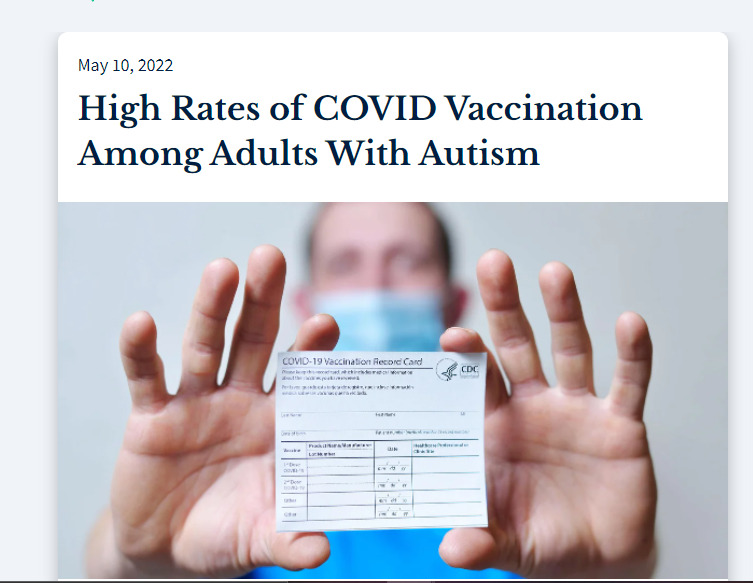 2022-05-10
2022-05-10High Rates of COVID Vaccination Among Adults With Autism
This is a news story from Health Day. Adults with autism have been shown to have higher rates of vaccination according to a new study. Those with autism are more at-risk for severe illness if they contract the disease, say researchers. To get the data, researchers sent online surveys to 431 autistic adults in Pennsylvania. They showed that about 78% of survey respondents said they had received or intended to get a COVID-19 vaccine, and more than 55% said that they had received at least one dose. In comparison, 42% of the overall adult population in Pennsylvania had received at least one dose of a COVID-19 vaccine as of the median response date for the survey (April 2, 2021), according to the study. The findings were published in the journal Vaccine. -
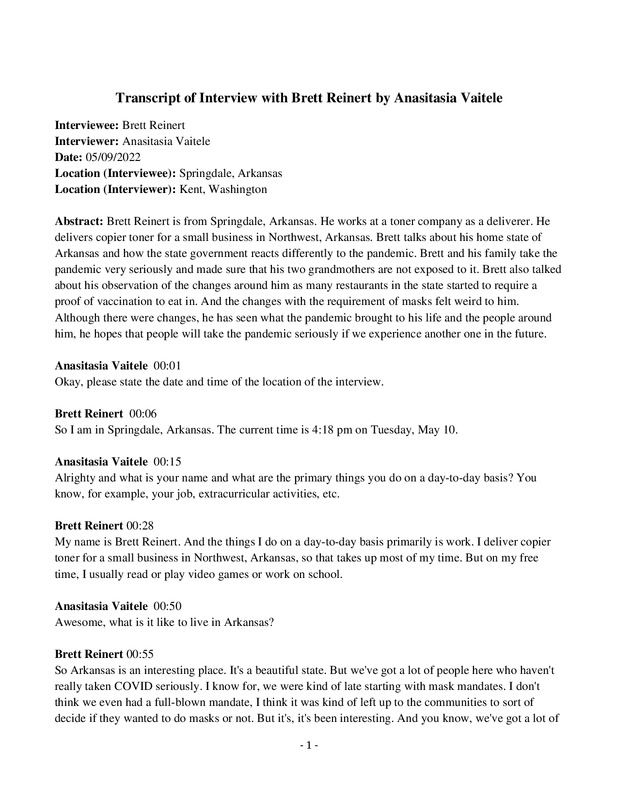 2022-05-09
2022-05-09Brett Reinert Oral History, 2022/05/09
Brett Reinert is from Springdale, Arkansas. He works at a toner company as a deliverer. He delivers copier toner for a small business in Northwest, Arkansas. Brett talks about his home state of Arkansas and how the state government reacts differently to the pandemic. Brett and his family take the pandemic very seriously and made sure that his two grandmothers are not exposed to it. Brett also talked about his observation of the changes around him as many restaurants in the state started to require a proof of vaccination to eat in. And the changes with the requirement of masks felt weird to him. Although there were changes, he has seen what the pandemic brought to his life and the people around him, he hopes that people will take the pandemic seriously if we experience another one in the future -
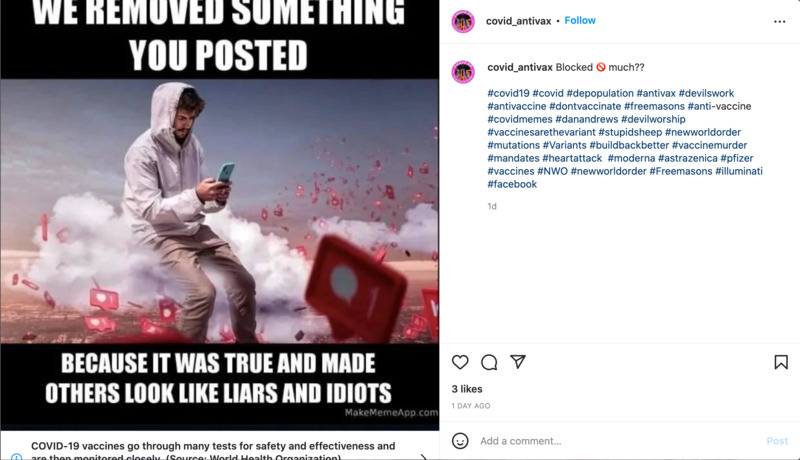 2022-05-11
2022-05-11Fact Checkers
This is an Instagram post by covid_antivax. This post is in criticism of social media removing posts deemed "misinformation" about COVID and the vaccine. The tags from this user, like #depopulation, suggest that the goal of COVID and the vaccines is to reduce the population size. The censoring of information regarding the virus and the vaccine has been troublesome for myself. I do not think it is the right of social media to dictate what can and cannot be said, barring anything illegal, like death threats. I think it is a dangerous trajectory when these multinational companies start deciding what governing bodies and people should think. It brings into question people's actual rights to speech. People should have the right to voice their opinion on subjects like this. If people are prevented from speaking out as much on social media, they will get driven to more niche websites and forums to discuss things, which in turn help create more echo chambers. The great thing about free speech is the ability to bounce ideas off with other people and be given the opportunity to decide for myself what is right with more information available. Taking this away will make it harder to really test ideas and make them more refined. This is more my criticism of social media in general, but the talk on the virus and the vaccines has noticeably made it worse for any side to reconcile. -
 2022-05-12
2022-05-12Baby Formula Shortage
This is an Instagram post by shanti.mikel. This post is on a conspiracy that the baby formula shortage is being used by Bill Gates to promote artificial breast milk technology. Connected to this theory is Pfizer advising people to not breast feed. I would be curious to know what the vaccine's impact would be on breast feeding in the future, as mRNA vaccines like the one Pfizer has produced are going to be used to treat other diseases. The claim that breast feeding is not recommended with COVID vaccines originated in Britain's medicines regulator, not Pfizer, according to Reuters. In order to give more context to this post, I have posted the story by Reuters as well, for those interested in reading. For me personally, I still don't think all the side-effects from the vaccines will be known for a while, as I have had a hard time getting information on the vaccines that has not come across as highly partisan for one group or the other. The evidence I rely on is mostly anecdotal from people that have received the vaccines, in addition to the reasoning of people that did not get them. For the people in my immediate circle, I have not seen any ill health effects from the vaccines so far, but I am also unsure how effective the vaccines are in the long run if some of those same people still get COVID anyway. It is hard to tell if the vaccine is making the COVID cases more mild, or if the virus has just mutated enough to where it is less deadly. It could be a mixture of both. All of it is hard for me to really be sure about either side because I feel like I am only getting partial truth from both. -
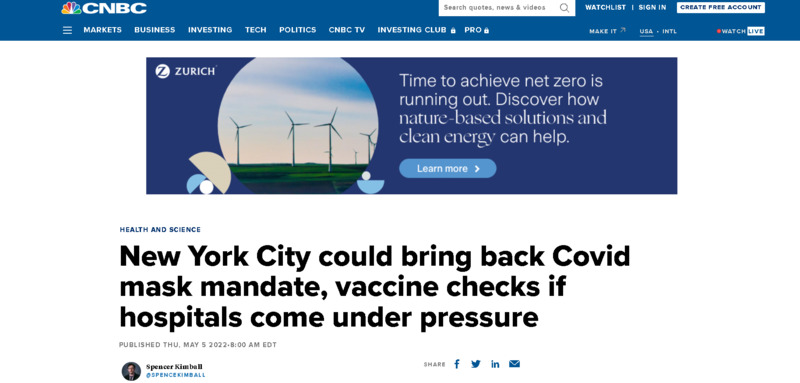 2022-05-05
2022-05-05New York City could bring back Covid mask mandate, vaccine checks if hospitals come under pressure
This is a news story from CNBC News by Spencer Kimball. New York City might bring back the mask mandate and vaccine checks if hospitals become too overwhelmed. New York City increased its COVID alert level from low to medium earlier this week as infections have kept on rising. Health Commissioner Ashwin Vasan said New York might reinstate mandatory masking and vaccine checks if the city raises its Covid alert level to high. New York's alert system is based off of CDC guidance and hospital protocols. Mayor Eric Adams ended mandatory vaccine checks at restaurants and other indoor venues in March, in addition to the mask mandate for people attending school. Masks are still required on buses, rail, and on subways in New York City. New York City, as of right now, has 80% of their population fully vaccinated. -
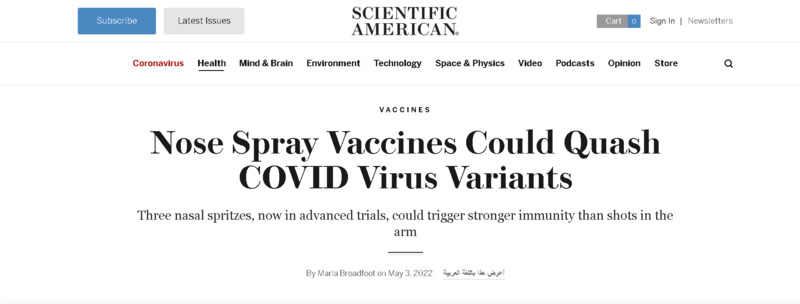 2022-05-03
2022-05-03Nose Spray Vaccines Could Quash COVID Virus Variants
This is a news story from The Scientific American by Marla Broadfoot. With the effectiveness of vaccines waning due to new variants coming about, scientists have been coming up with new ways to combat the virus. Scientists are thinking of developing a nose spray vaccine that attacks the virus at the source. It is believed that a vaccine delivered this method could trigger mucosal immunity. Nasal vaccines have been shown in the past to be more effective than traditional administration of vaccines. There is risk in this, however, because there still needs to be more research done on mucosal immunity. The advantage is that this vaccine does not rely on syringes or needles, so it has the possibility of reaching more people. -
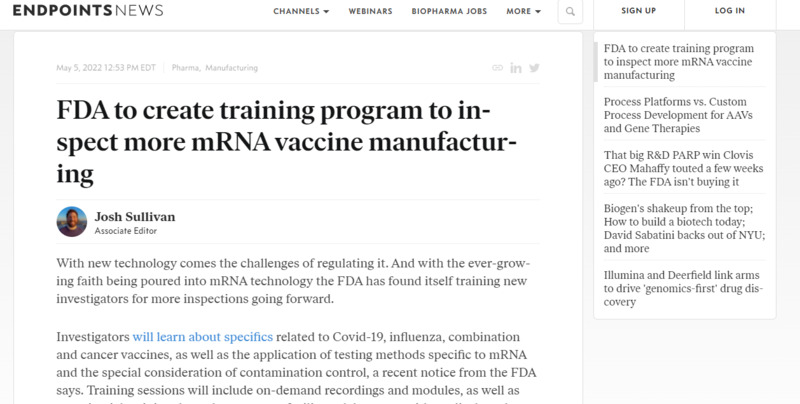 2022-05-05
2022-05-05FDA to create training program to inspect more mRNA vaccine manufacturing
This is a news story from Endpoints News by Josh Sullivan. With new faith being poured into mRNA vaccines, a new training program is being developed to help with the manufacturing process. This program will entail learning the application of mRNA vaccines, as well as laboratory training. BioNTech, Pfizer’s partner in its Covid-19 vaccine efforts, recently revealed that it is paying Matinas BioPharma to gain exclusive access to its lipid nanocrystal drug delivery platform for the oral delivery of mRNA. It also was one of the first companies to announce plans for the massive mRNA manufacturing sites that are being built. BioNTech plans to piggyback off the success of the technology by pivoting to work on malaria vaccines once the Covid-19 pandemic has subsided. -
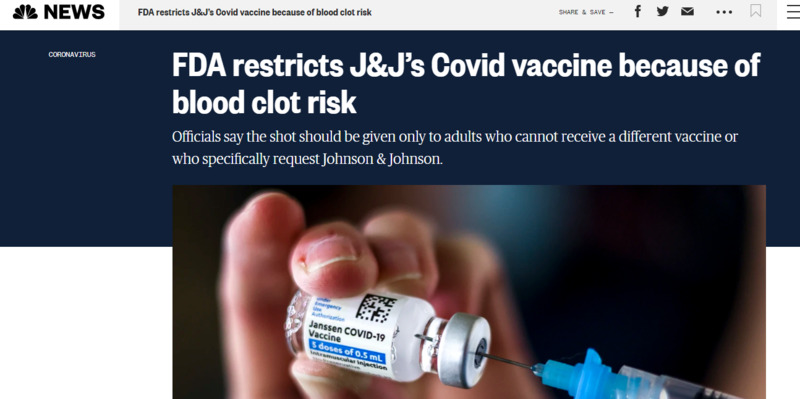 2022-05-05
2022-05-05FDA restricts J&J’s Covid vaccine due to blood clot risk
This is a news story from NBC News by The Associated Press. Due to new findings, the J&J vaccine has been restricted by the FDA due to blood clot risks. It is not to be given to anyone unless they can't receive a different vaccine. Americans are now recommended to only be using Pfizer or Moderna shots instead. -
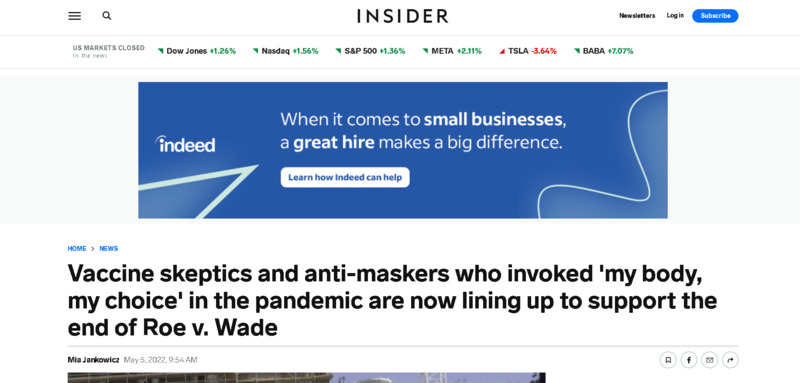 2022-05-05
2022-05-05Vaccine skeptics and anti-maskers who invoked 'my body, my choice' in the pandemic are now lining up to support the end of Roe v. Wade
This is a news story from Business Insider by Mia Jankowicz. This is about the argument of bodily autonomy as it applies to abortion and COVID. People have argued that vaccine passports and masks are infringements of civil liberties. The author writes that this is a mirror of what pro-choice advocates say. Some have argued that the anti-vaccine and anti-mask views being conflated with bodily autonomy arguments do not make sense, as being unvaccinated poses a greater risk to others, whereas lack of abortion access could put the mother's life in danger. -
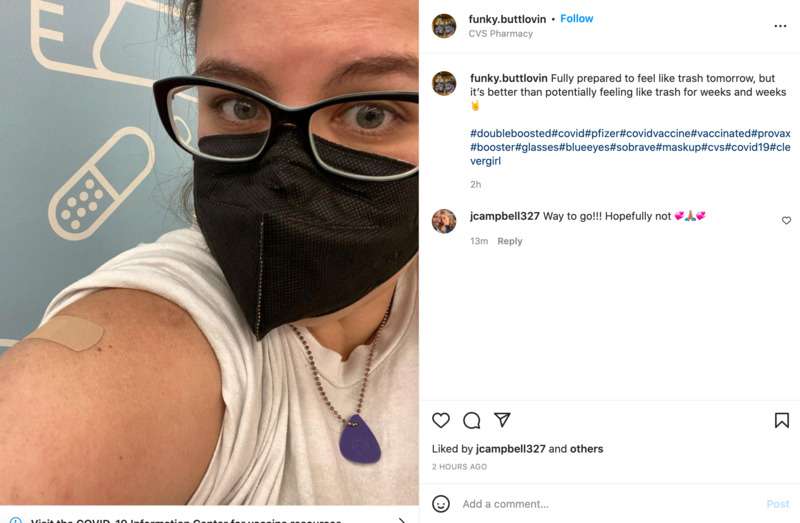 2022-04-29
2022-04-29Double Boosted
This is an Instagram post by funky.buttlovin. This person received their two extra doses of the COVID vaccine. People taking selfies has been a common trend on social media after having received a COVID vaccine. -
 2022-04-25
2022-04-25Covid Green Pass
This is an Instagram post by informa_mente_italia. It is criticizing the use of the Green Pass in Italy, where vaccination status is checked at certain places. The picture shown is making fun of the people that get the vaccines, and there are many needles to show that they are never ending, due to booster shots. This is a political issue within Europe at the moment because the Green Pass for COVID controls movement of people and what parts of society they are allowed to participate in. -
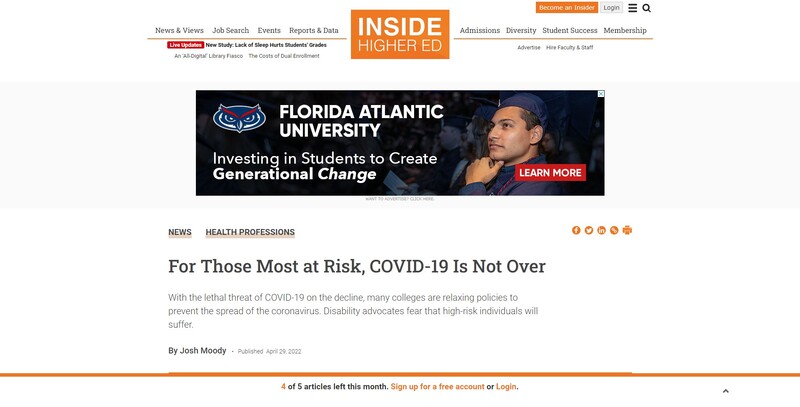 2022-04-29
2022-04-29For Those Most at Risk, COVID-19 Is Not Over
This is a news story from Inside Higher ED by Josh Moody. As schools begin to resume to pre-COVID standards, not all are happy with this change. Those with disabilities worry about the loosening guidelines and how it would affect their health. COVID rates vary across the country, but many colleges are starting to drop protocols. Some disability advocates claim that this is a wrong decision from the colleges doing this, as it is putting people at high risk in more danger. COVID Safe Campus, a group of high-risk academics and activists with disabilities, recently launched a report card grading college coronavirus policies. The effort, they say, grew out of concerns that high-risk individuals are being left behind as colleges return to pre-pandemic normalcy. Colleges are graded on masking, COVID-19 testing and vaccination policies, and access to remote learning. Of the 90 institutions graded from this organization, majority have received a D or an F, and none earned an A. -
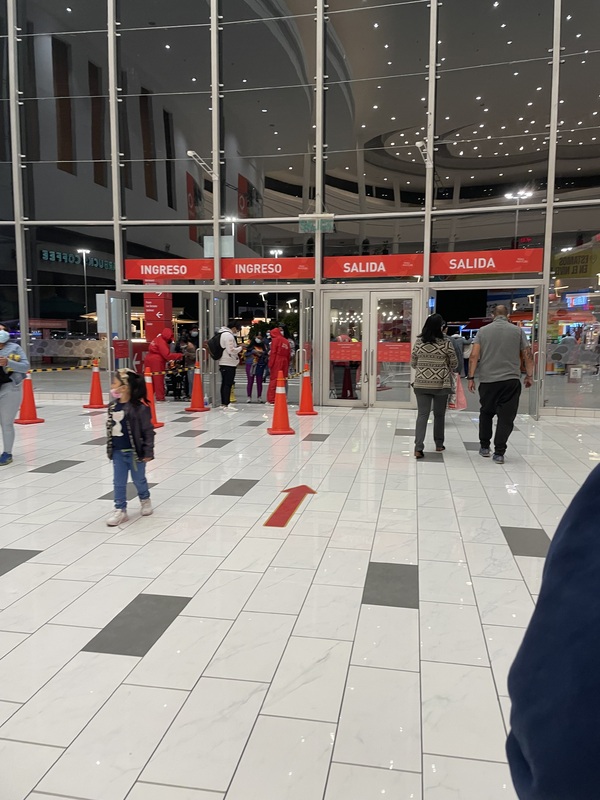 2022-04-27
2022-04-27Vaccine checks at mall entrance
Before entering the mall, all shoppers must show a security guard their ID and a vaccine card. This photo shows the people coming in and getting checked at the Mall de Porongoche. -
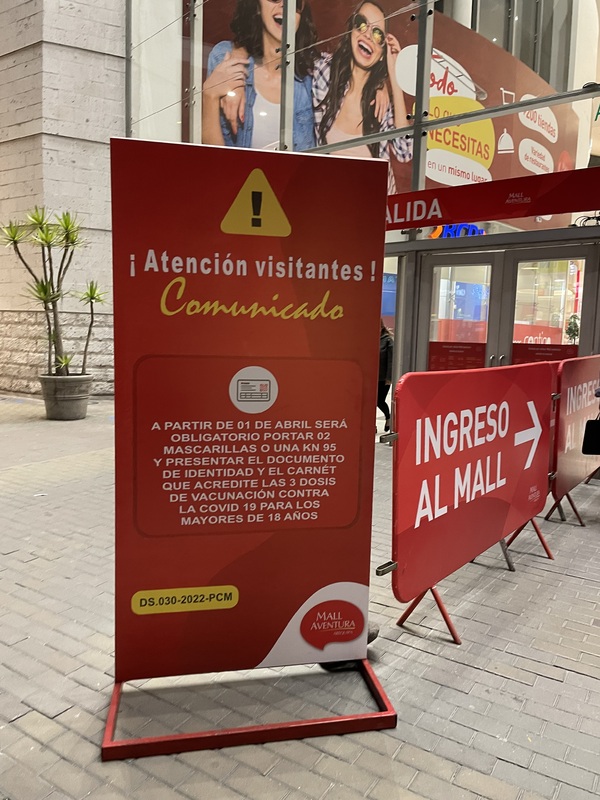 2022-04-25
2022-04-25Sign outside mall in Peru
Outside the mall de Porongoche in Arequipa, Peru this signs lets people know that starting on April 1st, it is required to use 2 masks or an N-95 mask and present your ID and vaccine card (showing 3 doses) before entering the mall. -
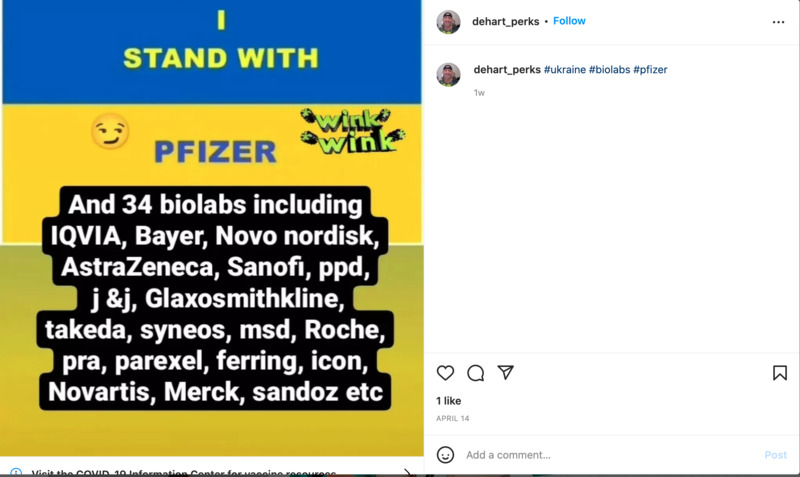 2022-04-14
2022-04-14Biolabs
This is an Instagram post by dehart_perks. This is a parody of the "I Stand with Ukraine" social media trend that became popular with the Russian invasion of Ukraine. It is making fun of people that follow the media narrative, whether it is for which side to support in a war, or getting vaccinated. The extra things that are added, are biolabs, which some believe are responsible for helping create COVID itself. -
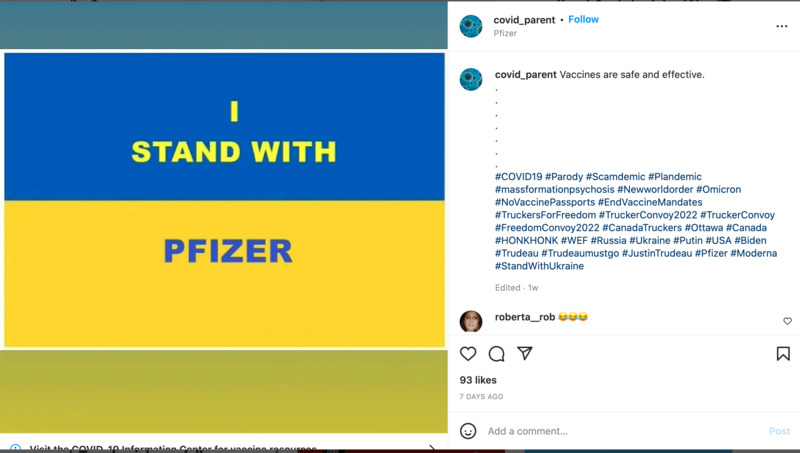 2022-04-15
2022-04-15I Stand With Pfizer
This is an Instagram post by covid_parent. This is a parody of "I Stand with Ukraine" posts that have become popular over social media since the Russian invasion of Ukraine. Instead of saying that they stand with Ukraine, it is saying they stand with Pfizer, a pharmaceutical company. It is mocking the type of people that just follow any trend, whether it is vaccines, or which side to support in a war. The hashtags call the pandemic a "scamdemic" and references the "New World Order." These tags indicate the overall feeling that the pandemic is partly, or completely planned, in order to exert more control over people and limit their freedoms. -
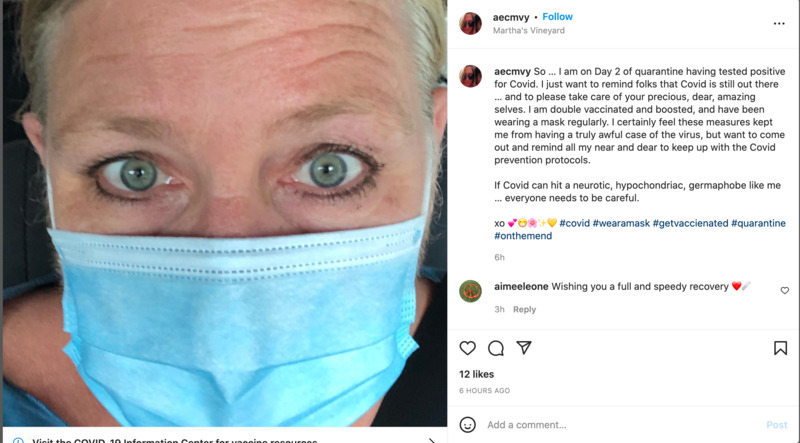 2022-04-22
2022-04-22Everyone Needs to be Careful
This is an Instagram post by aecmvy. This person is reminding everyone that COVID is still out there. Right now, she is quarantining. In the hashtags, she advises people to wear a mask, get vaccinated, and quarantine.
